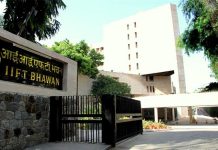Profit and Loss Questions for IIFT PDF
Download important IIFT Profit and Loss Questions PDF based on previously asked questions in IIFT and other MBA exams. Practice Profit and Loss questions and answers for IIFT exam.
Download Profit and Loss Questions for IIFT PDF
Get 50% Off on IIFT & Other MBA Test Series
IIFT Previous year question answer PDF
Practice IIFT Mock Tests
Instructions A dealer deals only in colour TVs and VCRs. He wants to spend up to Rs.12 lakhs to buy 100 pieces. He can purchase a colour TV at Rs.10,000 and a VCR at Rs.15,000. He can sell a colour TV at Rs.12,000 and a VCR at Rs.17,500. His objective is to maximize profits. Assume that he can sell all the items that he stocks.
Question 1: The maximum profit, in rupees lakh, the dealer can earn from his original stock if he can sell a colour TV at Rs. 12200 and VCR at Rs.18300 is
a) 2.64
b) 2.49
c) 2.72
d) 2.87
Question 2: Gopal went to a fruit market with certain amount of money. With this money he can buy either 50 oranges or 40 mangoes. He retains 10% of the money for taxi fare. If he buys 20 mangoes, then the maximum number of oranges he can buy is
a) 25
b) 20
c) 18
d) 6
Question 3: Instead of a metre scale, a cloth merchant uses a 120 cm scale while buying, but uses an 80 cm scale while selling the same cloth. If he offers a discount of 20% on cash payment, what is his overall profit percentage?
a) 20%
b) 25%
c) 40%
d) 15%
Instructions Answer the questions based on the following information. A watch dealer incurs an expense of Rs. 150 for producing every watch. He also incurs an additional expenditure of Rs. 30,000, which is independent of the number of watches produced If he is able to sell a watch during the season, he sells it for Rs. 250. If he fails to do so, he has to sell each watch for Rs. 100.
Question 4: If he is able to sell only 1,200 out of 1,500 watches he has made in the season (and the rest 300 are sold out of season), then he has made a profit of
a) Rs. 90,000
b) Rs. 75,000
c) Rs. 45,000
d) Rs. 60,000
Question 5: Once I had been to the post office to buy five-rupee, two-rupee and one-rupee stamps. I paid the clerk Rs. 20, and since he had no change, he gave me three more one-rupee stamps. If the number of stamps of each type that I had ordered initially was more than one, what was the total number of stamps that I bought?
a) 10
b) 9
c) 12
d) 8
Instructions Answer the questions based on the following information. A salesman enters the quantity sold and the price into the computer. Both the numbers are two-digit numbers. But, by mistake, both the numbers were entered with their digits interchanged The total sales value remained the same, i.e. Rs. 1,148, but the inventory increased by 54.
Question 6: What is the actual quantity sold?
a) 28
b) 21
c) 82
d) 14
Question 7: The price of a Maruti car rises by 30% while the sales of the car come down by 20%. What is the percentage change in the total revenue?
a) -4%
b) -2%
c) +4%
d) +2%
Instructions
Directions for the following two questions:
Mr. David manufactures and sells a single product at a fixed price in a niche market. The selling price of each unit is Rs. 30. On the other hand, the cost, in rupees, of producing x units is $240 + bx + cx^2$ , where b and c are some constants. Mr. David noticed that doubling the daily production from 20 to 40 units increases the daily production cost by 66.67%. However, an increase in daily production from 40 to 60 units results in an increase of only 50% in the daily production cost. Assume that demand is unlimited and that Mr. David can sell as much as he can produce. His objective is to maximize the profit.
Question 8: What is the maximum daily profit, in rupees, that Mr. David can realize from his business?
a) 620
b) 920
c) 840
d) 760
e) Cannot be determined
Question 9: Five horses, Red, White, Grey, Black and Spotted participated in a race. As per the rules of the race, the persons betting on the winning horse get four times the bet amount and those betting on the horse that came in second get thrice the bet amount. Moreover, the bet amount is returned to those betting on the horse that came in third, and the rest lose the bet amount. Raju bets Rs. 3000, Rs. 2000 and Rs. 1000 on Red, White and Black horses respectively and ends up with no profit and no loss.Which of the following cannot be true?
a) At least two horses finished before Spotted
b) Red finished last
c) There were three horses between Black and Spotted
d) There were three horses between White and Red
e) Grey came in second
Question 10: I sold two watches for Rs. 300 each, one at the loss of 10% and the other at the profit of 10%. What is the percentage of loss(-) or profit(+) that resulted from the transaction?
a) (+)10
b) (-)1
c) (+)1
d) (-)10
Top 500+ Free Questions for IIFT
IIFT Previous year question answer PDF
Answers & Solutions:
1) Answer (A)
And now total selling price will be = $12200 \times 60 + 18300 \times 40$ = 1464000
Hence profit = selling price – cost price
= 1464000 – 1200000
= 264000 rs.
2) Answer (B)
Let’s say the amount of money Gopal has is 100x rs. With this money he can buy either 50 oranges or 40 mangoes.
Hence, the cost of 1 orange = $\dfrac{100x}{50}$ = Rs. 2x
Similarly, the cost of 1 mango = $\dfrac{100x}{40}$ = Rs. 2.5x
Taxi fare = 0.1*100x = 10x
Remaining money with Gopal = 90x
Cost incurred in buying 20 mangoes = 2.5*20 = 50x
Hence, the amount of money left with Gopal = 100x – 10x – 50x = 40x
Therefore, we can say that with this much money he can but a maximum of $\dfrac{40x}{2x}$ = 20 oranges.
3) Answer (A)
Lets say the cost of the cloth is x rs per metre. Because of the faulty meter, he is paying x for 120 cms when buying.
So cost of 100 cms = 100x/120. He is selling 80 cms for x, so selling price is 100x/80. discount = 20%
so selling price is .8*100x/80= x
profit = x – 100x/120 = x/6
Profit % = x/6 divided by 100x/120 = 20%
4) Answer (B)
Cost price per watch = 150
Cost price for 1500 watches = $1500 \times 150$ = 225000
Total expense = 225000 + 30000 = 255000
Selling price for season = $1200 \times 250$ = 300000
For out of season = $300 \times 100$ = 30000
Total selling = 300000 + 30000 = 330000
Profit = 330000 – 255000 = 75000
5) Answer (A)
As shopkeeper gave 3 one-rupee change for 20 rs. change, Buyer must have ordered for a total of 17 rs. stamps.
Now buyer ordered for at least more than 1 stamp for each type
Hence the minimum he bought was:
2 stamp for 5 rupees = 10 rs.
2 stamp for 2 rupees = 4 rs.
2 stamp for 1 rupee = 2 rs.
For the total to be seventeen, the buyer must have purchased 3 one rupee stamps.
And 3 one rupee stamps were also there as changes given by shopkeeper.
So total number of stamps = 2+2+(3+3) = 10
6) Answer (A)
Total sales value = 1148
Now 1148 can be represented as $41 \times 28$ and $82 \times 14$ i.e. product of interchanged numbers.
As inventory is increased by 54, so quantity sold should be 28.
7) Answer (C)
let’s say price of maruti car is x rs.
Sales = y
revenue = xy
Changed price = 1.3x
changed value of sales = 0.8y
new revenue = 1.04 xy
Percentage change in revenue = 4%
8) Answer (D)
Cost of 20 units = 240+20b+400c
Cost of 40 units = 240+40b+1600c = 5/3 * (240+20b+400c) => 720+120b+4800c = 1200+100b+2000c
=> 480 = 20b + 2800c => 120 = 5b + 700c
Cost of 60 units = 240+60b+3600c = 3/2 (240+40b+1600c) => 480 + 120b + 7200c = 720 + 120b + 4800c
=> 240 = 2400c => c = 1/10 and b = 10
Let the number of items needed for max profit be k
CP = $240+10k+k^2/10$
SP = 30k
Profit = SP – CP = $30k – 240 – 10k – k^2/10$ = $20k – 240 – k^2/10$
Maximum when 20 – k/5 = 0 or k = 100
Profit = 2000 – 240 – 1000 = 760
9) Answer (D)
In total Raju bets 6000Rs and ends up with no profit – no loss. So there are 3 possibilities.
1) White comes 2nd, Black comes 4th and Red comes 5th.
2) Black comes 1st, White comes 3rd and Red comes 4th or 5th.
3) Black comes 2nd, Red comes 3rd and White comes 4th or 5th.
So there can never be 3 horses between white and red according to above to possibilities. Hence option D cannot be true.
10) Answer (B)
Selling price of first watch = 300
Profit = 10%
cost price = $\frac{300}{1.1}$
Selling price of second watch = 300
Loss = 10%
cost price = $\frac{300}{0.9}$
Total selling price of transaction= 600
Total cost price of transaction = $300(\frac{10}{11} + \frac{10}{9}) = 600 (\frac{100}{99})$
Loss = $600 (\frac{100}{99} – 1)$
%loss = $(600 (\frac{100}{99} – 1)) \div (600(\frac{100}{99})) \times 100 = 1$
IIFT Previous year question answer PDF
We hope this Profit and Loss questions and answers PDF will be helpful to you.





